It’s quite a phone call to get: ‘Will you go to Brazil for us?’
I was sitting in the shed looking over pretty much the final draft of a book that had to be done by July. I felt the book was okay, but even if it hadn’t been, you don’t say no to calls like that.
The British Council were looking to send a couple of writers out to FLIP – a literary festival in Paraty, (pronounced Par-a-chee), which is a few hours south of Rio. I knew it would put more pressure on finishing the book. I’d also wanted to put to bed another novel, again by July.
So when I actually got on the train to start the trip I hadn’t really taken the fact on board. It was only when I hit São Paolo airport that things really sunk in.
Paraty
The first thing that struck me when I left the airport at Rio were the frigate birds. I wasn’t expecting that. And flocks of egret.
I was with fellow Granta contributor Andrea Stuart, whose memoir ‘Sugar in the Blood’ traces the hidden legacy of sugar plantation slavery in her own family and modern British life. For her, the Brazil we saw was immediately like Barbados but for the scale of things. She had a sense of home from it. For me, I had a sense of distance.
When we stopped en route for a coffee there were small dark honey bees all over the counter and in the cups and on the food. Their determined energy contrasted strangely with the way I was feeling, having been travelling for so long. Their type of energy was something I would see a lot in Brazil.
We were staying ten minutes out of Paraty in a small bay. After stowing my bags I walked out and took in the view across the beach and let the travel dissipate. Apparently the sun wasn’t usual for this time of year. The mountains beyond the bay were faint in that heat. It felt surreal to be there and strange being there for my writing. The bay was called Jabaquary, which means ‘calm water.’
As I stood contemplating this, a girl came past me on a kayak. She was topless. It was quite emotional.
We were met at the pousada (our bed & breakfast) by Luiz Coradazzi, who worked for the British Council in Brazil, and that evening we went into town.
We hit the caipirinhas. We had out first in what they call a ‘dirty feet’ bar and they were good caipirinhas, the best I tried the whole trip. The local cachaça made the difference.
Caipirinhas are the national drink of Brazil, based on a cane-sugar spirit called cachaça. Brazil drinks an astonishing 2,000,000,000 litres of this a year. (There is certainly sugar in their blood, Andrea.) The name caipirinha comes from caipira which would be ‘hillbilly’ in the US. You need cachaça, good limes and sugar. In Brazil they use limon subtil – a type of green lemon, but lime is the closest we can get.
A few drinks in we needed food. We ate pastel. That’s a kind of deep fried street food and is a work of genius. They were projecting images and quotes onto the wall of a church above us and the squares were filling up after the opening event. The energy and mix of the audience at the festival was immediately clear.
Very few people spoke English and Brazilian Portuguese is impenetrable. Like Welsh, if you don’t grow up speaking it, you simply can’t make the right sounds. But we got along.
We hit the caipirinhas again. The next morning, they hit us.
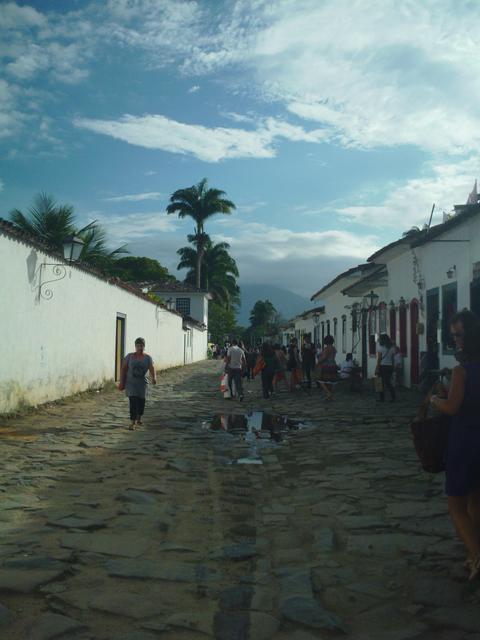
Thursday
I made myself get up and go for a walk but when I reached the end of the bay the beach ran out and turned into thick vegetation.
The tide was out and I considered crossing to the far shore but there was a mineral black mud. The second step I went in above the knee. I recognized it would not be a good idea.
A shale coloured egret got up and flew off over the water.
On the way back down the beach I saw the kayak for hire. I slid it into the water and headed it out to a set of rocks some few hundred yards out in the bay. I felt a sense of arrival immediately.
Small boats worked nets close to the shore. Every now and then a fish jumped, or there was a skittering just under the surface as small petal-shaped fish shoaled and left the water. Terns mobbed the black vultures that bothered them on the rocks.
Beyond the bay the scale of the mountains was clear. The scale of the country was clear. That’s something Andrea kept picking up on but I guess I was expecting it. The massiveness of Brazil.
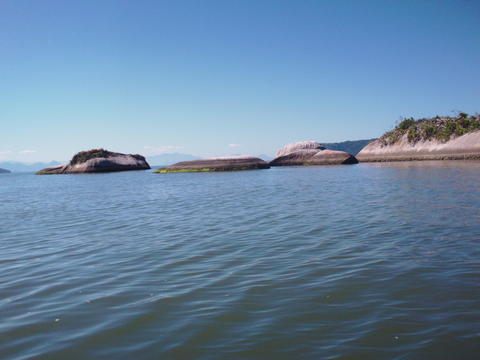
It’s the similarities that fascinate me first when I travel. There were a pair of turnstones on one of the rocks – winter birds I associate with the beach I grew up by. While the bars, the roads, the people, the food, the furniture – the man-made things – were mostly different, the feel of the sea under me was common and the same.
An hour or so out the sun seemed to flex. I had water with me and I’d suntan-lotioned my face but my shins would burn, I knew that. I weighed it up and accepted it and wrapped my t-shirt round my head to keep the sun off, then I took the kayak into a little inlet.
It had a self-contained feel, was a slow pool more than anything. The water continued through the vegetation with a disquieting noise.
From the foliage was the monkey sound of parrots. Kingfishers and finches zipped across the water. There was a strange loud block noise from the trees, like a coconut falling in a cartoon.
With the heat and the sound, I felt a foreignness I hadn’t on the open sea. This was different. I felt for the first time a small nervousness. There was a lump in the water. A hurry under the surface, strangely disconcerting.
Letting myself float up to the short cliff spilled with plants I felt that odd thing: that awareness you are experiencing something you will never experience again.
I cut out of the inlet and drifted the kayak up to the big rocks and then followed the shore into the mangrove.
I’d never seen this. All the roots on show, exposed and elaborated. When I got back to the beach, and in the town, I saw that in the people.
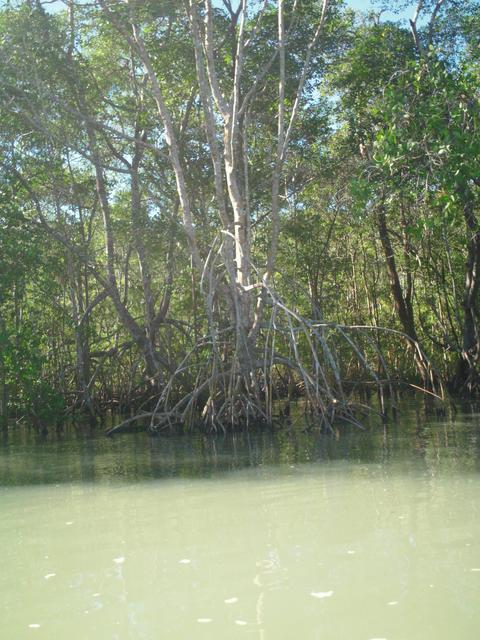
Event, Friday
Maybe because the mix is so visible and vibrant there seems a real intent in Brazil to determine a cohesive definition of themselves. They have two years before the World Cup and four before the Olympics and this seems to have focussed them. That fed into the event.
Some were surprised by my suggestion that Britain is essentially ‘branded’ to the rest of the world, and that the brand is London-centric. Most hadn’t realized Britain was made of four nations, and though they had a vague notion of Scotland and Ireland, hadn’t really got round to separating them from Union Jacks and the Queen. Very few people knew Wales.
There was an enthusiasm to hear more about a Britain they weren’t aware of. Be it Andrea’s ‘Afro-Caribbean’ Britain, or my rural Welsh one. Perhaps this came from an awareness of the scale of Brazil, and the mix of the 190 million people there. Or perhaps it came from a sense they were an emerging economy, and that one of the old ones wasn’t so tough any more.
After the event we ate Moqueca – a Brazilian fish stew. It was excellent. The key question from the previous evening arose again, to much discussion: Would you rather be attacked by twelve duck-sized horses, or one horse-sized duck?
When I got home, there was a frog in my shower.
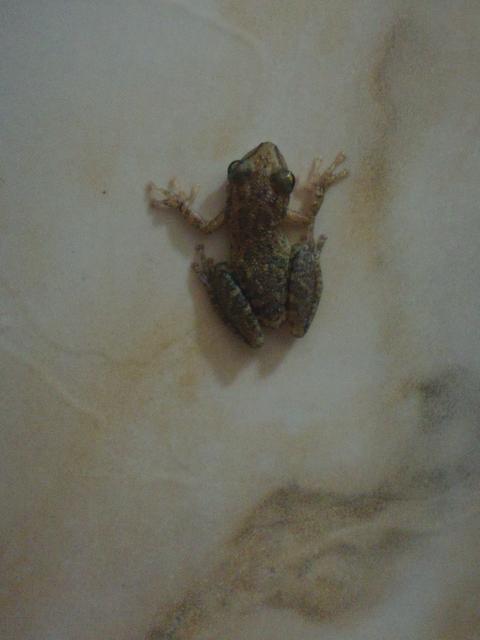
Flupp
The weather broke on Saturday evening and it rained the next day all the way to Rio. I wondered if the frog had been a sign of breaking weather.
When I arrived, the Copacabana was deserted. You could hardly see the beach through the rain.
I couldn’t shake Barry Manilow; when I did I got The Girl from Ipanema, which kept sidling off into Terence Trent D’Arby’s Sign Your Name. Disastrous with a twenty-six hour trip ahead.
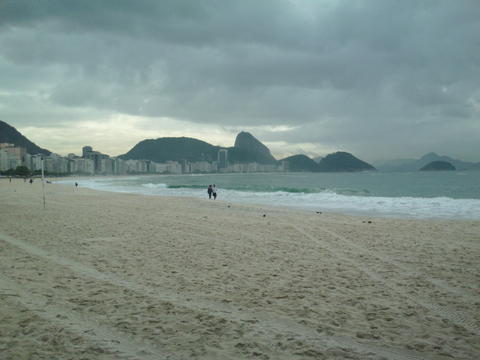
It brightened the next morning and I walked up the sand. It was an incredibly fine sand and made my teeth itch. There wasn’t a bikini in sight, but then I’d seen a topless kayaker. The world works in balances.
Along the street were chrome exercise stations. I guess if you eat deep fried sandwiches you need such things. I tried to picture our bus stops at home fulfilling such a function but didn’t get very far with that.
The waves were cavernous, which I wasn’t expecting. Men were body surfing.
A man with a rake walked into the receding water, dug in the rake then dragged it backwards as the wave ebbed. Then he picked through the attached net for shrimp.
As the clouds shifted the temperature climbed and people came onto the beach. I saw a fully grown man doing a handstand. An hour later I was in Morro dos Prazeres.
The favela is not like anything else. The houses stay somehow, anyhow. Despite the appearance of being largely empty, there’s a sense they teem with life. It’s a kind of coral. A kind of dripped candlewax way to build.
The plan is to wipe it out and build expensive property on the real estate. (Surely, the people can’t be happy here, right?) I’ve rarely met people with more sense of themselves. Behind the favela, on Corcovado mountain, you can see the huge, bright statue of Christ.

The event was unique. One half of the room was a group of aspiring writers, the other children from a junior school. It was brief for me, and I had to leave directly after the event, taking with me just an instinctive, snatched sense of the place.
My favourite question of the whole trip, asked by an eight-year-old to John Freeman and myself was simple and Brazilian: ‘Do you play football?’ We both did.
Pastel
For want of a more elaborate description, a pastel is a deep fried sandwich.
I ate mine filled with jerk beef and Brazilian cream cheese. One shop sold forty different fillings. Prawn was popular. Banana for those who preferred something sweet. Palm hearts too, but they’re not easy to find. Have a filling ready before you make the dough.
I haven’t done this yet but I’m going to slow-cook a beef shin in smoked salt and spice, and see how that works.
2 cups of flour
1 tablespoon of cachaça (or vodka)
1 tablespoon margarine
1/3 cup warm water with 2 pinches of salt
½ teaspoon baking powder
1 egg
Sift the flour and the baking powder into a large bowl and add the margarine, cachaça and egg. Mix it, then add the warm water a slug at a time, still mixing, to make a dough. I guess you could just throw everything into an electric mixer.
Tip the dough onto a flat surface and knead it for fifteen minutes or so, then roll it flat.
Next, halve the dough, and flatten it with a rolling pin. Keep halving what you have until you have thin elastic strips about six inches or so wide. Lay these on a floured surface.
Fill the strips and fold them over, then cut the parcels out with an upturned glass. The glass will press the edges together put pinch the seams to make sure they close.
Deep-fry the pastel at 350°F until they float, when they should be ready. Pat dry with kitchen roll and serve. I’d suggest a few caipirinhas first.
Photographs courtesy of Cynan Jones






